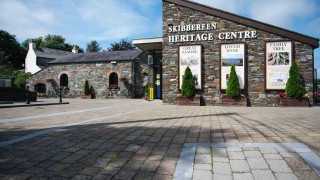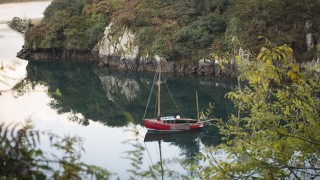
Skibbereen
The market town of Skibbereen is an enterprising, vibrant and friendly town. Characterised by its many colourful, traditional buildings and shopfronts, the town has a strong local community spirit. With a vibrant artistic community represented by the West Cork Arts Centre and other galleries, it is a renowned for its arts and crafts people.

DIRECTIONS
Located on the N71, 85km west of Cork city.
SPECIAL AREAS OF CONSERVATION
Lough Hyne, Knockomagh Woods.
About
Skibbereen has often been referred to as the ‘Capital of the Carberies’ and its central location along the N71 makes it the perfect base from which to explore the many surrounding harbours and villages. The nearby fishing village of Baltimore provides a gateway to Carbery’s Hundred Isles in Roaringwater Bay with daily ferry services operating to Ireland’s most southerly inhabited Gaeltacht Island of Cape Clear and the charming islands of Sherkin and Heir Island. Skibbereen has much to offer as a diverse holiday destination. Whatever your interest — from stunning scenery, gardens, walking and cycling to the numerous water-based activities on offer, Skibbereen and its neighbouring villages are sure not to disappoint.
A unique attraction, located 5km outside Skibbereen, is that of Lough Hyne. Lough Hyne, the only inland salt-water lake in Europe, was designated as Ireland’s first marine nature reserve and is home to a diverse range of plants and marine life. Combined with the wooded walk to the summit of Knockomagh hill with its panoramic views over the lake and Baltimore, a trip to Lough Hyne is a must for visitors to the area.
Skibbereen is a town where people’s passion for artisan food and craftwork is strongly evident, with many artists, crafters and food producers choosing to set up base here. The Farmer’s Market, held each Saturday in the town, is ever popular and widely known as providing an excellent display of fresh local produce and some of the best of West Cork’s food and crafts. The town also offers a good selection of high quality cafes and restaurants where local produce takes pride of place.
Skibbereen and its surrounds provides a truly fulfilling holiday experience with something for all tastes and interests.
Information courtesy of www.skibbereen.ie, Skibbereen Heritage Centre & Skibbereen Tourist Office.
VILLAGES NEARBY: Castletownshend
Castletownshend is a village about eight km from Skibbereen. The village developed around a small 17th century castle built by Richard Townsend, whose descendants still reside there.
The main street of the town, lined with large homes from the 18th century, runs down a sharply sloped hill leading to Castlehaven Harbour and the castle. St. Barrahane’s Church overlooks the town. It is noted for its stained glass windows, some by Harry Clarke. The sea inlet provides a sheltered harbour for inshore fishing boats and yachts. It is a popular port of call for cruising yachts in the summer months.
The village provided inspiration for writers Somerville and Ross and is a favourite spot of BBC Newsnight presenter Jeremy Paxman.
Discover the Locality
History
Skibbereen town was established after the infamous Sack of Baltimore in 1631, when Algerian pirates raided the nearby seaside village. Understandably nervous after the attack, the remaining Baltimore residents moved up river to where the River Ilen meets the Caol and established the town that we know today. The town charter dates to 1675 and a copy of this can be seen at Skibbereen Heritage Centre.
Skibbereen serves a huge hinterland including the villages of Baltimore, Union Hall, Glandore, Ballydehob and Schull. Its streets are full of life and character and shops that are still locally owned. Records from the early 19th century report it to be a thriving town serving the agricultural hinterland and a centre for the then-booming linen trade as well as having numerous mills.

The sad events of the Great Famine had a huge impact on the Skibbereen area and reports of the hardship suffered by its residents appeared on the front pages of British and international newspapers of the era. Skibbereen became synonymous with the Great Famine and the song ‘Dear Old Skibbereen’ is a well-known Famine anthem. The Skibbereen Poor Law Union was one of the worst-affected areas in the country, losing about a third of its people to death, emigration and migration. The Famine graves at Abbeystrowry, where between 8,000-10,000 victims are buried in mass graves, are silent testament to the suffering of the people.
Skibbereen Heritage Centre
Skibbereen Heritage Centreis located in the historic Old Gasworks building, just on the outskirts of Skibbereen town. It has a full exhibition on the Great Famine and its effects, both on the Skibbereen area and nationally. With audio visual presentations giving contemporary primary-source accounts of the era, touch screen centres as well as artefacts and information boards, the exhibition offers an overview of this pivotal period of Irish history. Follow The Skibbereen Trail, a walking tour of Skibbereen town which incorporates sites relating to the Great Famine.
Skibbereen Heritage Centre offers audio visual presentations on Lough Hyne, a local marine lake which is Ireland’s first Marine Nature Reserve. This marine lough is home to a rich and varied sea-life including many rare and unusual species. First ‘discovered’ by scientists in 1886, it is now one of the most-studied sites of its size in the world, with hundreds of scientific papers written on studies carried out there.
Skibbereen Heritage Centre also offers a genealogy service for the West Cork area (by appointment) which includes Roman Catholic Church records, Tithe Applotments, Griffith’s Valuation as well as census records. Other miscellaneous records on offer include local estate records, graveyard surveys and loans funds records.
The Skibbereen Trail
The Skibbereen Trail is a tour in which the walker visits sites which have direct links with the Great Irish Famine. Each site is unique. Some commemorate great works of philanthropy, others of emigration, more of Relief Schemes, while others tell of famine, fever and death. The Trail offers an overview of conditions in the area during the period 1840-50. See the map for corresponding points.
1. The Square
Skibbereen Town Square was, in the 19th Century, known as Market Square. Here in 1847, the body of an unnamed boy, taken for lifeless, was placed in a ‘parish coffin’ and conveyed for burial to the Abbey Cemetery. There, as he was was lowered into the pit the youth regained consciousness, and was able to walk unaided from the grave.
The following year, one Thomas Guerin, also believed dead, was at the age of three years, retrieved alive from the same communal pit. Tom was destined to live on as the most celebrated Famine survivor in West Cork until his second and final interment in 1910.
2. The Home of Jerry Crowley, North Street
In this building lived Jeremiah Crowley. He was an apothecary, but is referred to as Dr. Crowley. Jeremiah Crowley survived the famine and in this building in 1856 he, O’Donovan Rossa and others founded the Phoenix National and Literary Society. Out of this society later developed the Fenian movement.
As you pass along North Street, you will notice the numerous porches which lead to the old quays and stores on the River Ilen. An old corn store at the end of Fallon’s porch was used as a government depot and at a later stage as an auxiliary workhouse.
3. The Becher Arms Hotel, North Street
Lord Dufferin and G.F. Boyle stayed here in February 1847. They had come from Oxford to ascertain for themselves the true state of famine conditions in Skibbereen.
Dufferin and Boyle purchased an “immense basket-full of loaves”. The starving of the town soon learned of their purchase. They surrounded the hotel. “At first we sent down to the door, but the rush was so great, that the scheme was impracticable, and it only remained to throw it out of the window.”
4. The O’Connell Meeting, Curragh Hill
Daniel O’Connell held a monster Repeal meeting on 22 June 1843 at Curragh Hill which rises above the level lands of the Ilen valley, directly opposite this spot. Contemporary accounts of the number of people present to hear O’Connell’s case for the repeal of the Act of Union with England vary from 75,000 upwards.
5. St. Fachtna’s De La Salle, North Street
The failure of the Public Works Programme
On Wednesday, September 30, 1846 between 800 and 1,000 roadworkers marched on Skibbereen. They were employed on the Public Works Relief Scheme north of the town. Wages were low, about 8d a day, and often workers had to wait weeks for their money.
In front of this building, soldiers primed and loaded as the roadworkers approached on the road which passed behind the school. For four hours, the demonstrators remained here. When asked to disperse, their constant reply was that “they might as well be shot as not”.
6. Windmill Hill
The Workhouse System
In the distance can be seen the high walls of the Skibbereen Union Workhouse and Fever Hospital. The workhouse system was designed to ensure that only the really destitute would seek admission. The workhouse was built to accommodate 800 people, but at the height of the famine it was grossly overcrowded. Many unclaimed victims from the workhouse were buried in n adjoining Paupers’ Graveyard.
7. Chapel Yard
On this site stood an old chapel. Here, during the famine years there was a watch-house which was originally built as a shelter for grave-watchers.
In February 1847, Elihu Burritt, an American visitor, described this watch-house: “… and into this noisome sepulchre, living men, women and children went down to die; … we found it crammed with wan victims of famine, ready and willing to perish.”
8. The Auxiliary Workhouse at Levis’ Quay
Response to Overcrowding
This building was used to provide extra accommodation. A.G. Stark who visited Skibbereen towards the end of the famine, tells us:
“I did not visit any of the poorhouses; indeed, the shrill sound of female voices that reached my ears as I passed one of them – Swanton’s Store – as if nothing reigned within, except discord and pain, rendered the invitation to enter anything but desirable.”
9. O’Donovan Rossa
Emigration a solution?
Jeremiah O’Donovan Rossa was one of a family of four. The potato blight affected the family fortunes. His father found work on the Public Works, took ill in March 1847 and died. In May 1847 the O’Donovan family were evicted. Rossa came to work here for his cousin’s husband while his family emigrated to the U.S. in 1848.
As you go through the Main Street car park, you will have passed through the site of Coppinger’s buildings, yet another auxiliary workhouse.
10. Townshend Street
Death on the street
An inquest of April 8, 1848 into the death of an unknown famine victim found at this spot, records “starvation” as the certified cause of death. In Skibbereen, the very first meeting in Europe of “The Temperance Society” was held in 1817. A Temperance Hall stood on this site from 1833-1964.
11. Abbeystrewery Church, Bridge Street
This beautifully proportioned Church (built 1890), is in fact the second to occupy the site. The square tower, however, dates from the original (1827). The present church was built during the incumbency of Rev. Canon James Goodman. He is the subject of the Memorial Arch at the gateway to the grounds. Canon Goodman won national recognition as a collector of countless Irish traditional melodies, now deposited in Trinity College Library, Dublin.
12. J.W. Clerke
J.W. Clerke was manager of the Skibbereen branch of the Provincial Bank. On February 6, 1847, as secretary of the Relief Committee, he wrote to the Commissary General, Sir Randolph Routh, that over the next four weeks they were planning to feed approxiamately 8,000 people per day. Clerke kept a time service in Skibbereen and was a keen amateur astronomer. His daughters became world authorities on astronomy.
13. The Poor Law Union Dispensary, Bridge Street
The town had a dispensary in 1824, serving the medical needs of over 21,000 people. Dr. Donovan, visiting this building in December, 1846 recorded that he… “scarcely entered it when a clamourous crowd rushed up the stairs.”
14. Charity Soup House, The Steam Mill, Ilen Street
Local, National and International Aid
The Committee of Gratuitous Relief established a Charity Soup House in what was then the newly built Steam Mill in October 1846. The soup was issued daily and huge numbers were fed. By February 1847, the Committee had received many subscriptions, some being local, others from Cork, Dublin and still more from England.
15. Bridgetown
An eyewitness account
James Mahony, the artist, best described the conditions in this part of town… “there I saw the dying, the living and the dead, lying indiscriminately upon the same floor, without anything between them and the cold earth, save a few miserable rags upon them.”
Bridgetown then consisted of about half a mile of street with thatched houses on each side. Many of the houses left empty after the famine were demolished.
16. Abbeystrewery House & Auxiliary Workhouse at Deelish
In local folklore this house is still referred to as “The Abbey Hospital”. During May 1847 Dr. Donovan demanded that prsioners who were in fever be removed to this hospital. Across the river from this house is Deelish Pier, the site of another auxiliary workhouse.
Dr. Donovan’s letters to the newspapers and medical journals give very vivid particulars of the economic, social and public health emergency which existed in Skibbereen. It was he, perhaps, who more than any other person helped to focus world attention on the plight of Skibbereen in the 1840’s.
17. The Famine Burial Pits, Abbeystrewery Cemetery
It is probable that there are between 8,000 and 10,000 famine victims buried here.
According to Lord Dufferin, burials up to Febraury 1847, were carried out in a very haphazard fashion… “In one corner there was about an acre of uneven freshly-turned earth… The bodies had been daily thrown in, many without a coffin, one over another.”
During the 1990’s, 150 years after the Great Famine, a major refurbishment was carried out on this site by the local community.
The aftermath…
One immediate consequence of the Great Famine was the death of a whole generation. In the town, whole lanes, like Coppinger’s, Table and Clerke’s lay deserted, while there were numerous unoccupied houses in Bridgetown, High Street and Chapel Lane.
Emigration was now common. Workhouses were more feared than ever. There was hatred. Many farm holdings had disappeared. The potato began to lose its dominant role in the Irish diet, while cattle and dairying began to increase.
The spirit of Republicanism which had been kindled in 1798 might have flickered in 1830’s and 40’s, but it sprang to life again in the late 1850’s, when the Phoenix Society began to make preparations for a revolution. The flames were no longer confined to Ireland, but were now fuelled by the famine emigrants who had settled in the U.S., Canada and England.
The Skibbereen Trail courtesy of Skibbereen Famine Committee
Things to do
Within 5km of Skibbereen you’ll find sandy beaches, secluded coves, fast-flowing rivers, lakes, hills and forests – all easily accessible for walkers, cyclists and drivers.
Lough Hyne
The enchanting Lough Hyne is Europe’s largest seawater lake and boasts an amazing array of unusual marine life. It is Ireland’s first Marine Nature Reserve and nestles in a fold of hills 5 km south west of Skibbereen.
This marine lake is fed from the sea by a narrow tidal channel known as ‘The Rapids’ and its surrounds are home to a rich and varied range of plants and animals, including many rare and beautiful species. Since it was ‘discovered’ by marine biologists in 1886, scientists have carried out pioneering research in experimental ecology. Their continued research into the factors governing the distributions of marine animals and plants make Lough Hyne one of the most studied marine sites of Europe. Despite this, scientists have still to unearth the mystery surrounding the fact that the lough is always some 3 degrees Celsius warmer than the sea and contains marine life usually only found in the Mediterranean.

Visit the Lough Hyne Interpretative Centre at Skibbereen Heritage Centre, which shows an audio visual in English, Irish, French or German, explaining the unique nature of the lake.
Lough Hyne is also an area rich in history and folklore. There are three holy wells, two of which are within easy walking distance of the lough. At St Bridgit’s well, it is said the knees of the saint have left impressions in the rock. The ruins of Cloghane Castle still remain in the island in the middle of the lough. This was one of the tower houses of the O’Driscolls, the overlords of the area and this small castle is said to be where the last great O’Driscoll chieftain, Sir Fineen, died in the early 17th century. The fable of the king with the ears of a donkey is also associated with this castle.
See Lough Hyne Loop Walk in the Walking section.
Golfing
Skibbereen & West Carbery Golf Course is an open 18-hole parkland golf course with panoramic views set against the backdrop of Lough Hyne, Ireland’s first marine nature reserve.
Fishing & Angling
The River Ilen offers salmon and sea trout game angling, from the town centre north for 5km, while the lakes of Shepperton (5km from Skibbereen) offer peaceful coarse fishing in gorgeous surroundings. Sea Angling is available from Glandore, Union Hall and Baltimore.
Cycling
The Skibbereen Cycling Hub has 3 routes, catering for all levels. See Cycling section for routes.
Swimming
There are several swimming spots around Skibbereen which are perfect for a summer’s day dip. Best of these is Tragumna, a small hamlet located about 5 km from the town with a small, safe, blue-flagged beach. There is a tiny island located about 100 metres offshore. It can be reached by turning off the R596 at Abisdealy Bridge and follow sign for Tragumna. This beach is not lifeguarded but life buoys are provided at the beach.
Skibbereen Market
The market in the Fair Field each Saturday is a true success story. Thanks to the tenacity of its founding traders the market is now one of the most successful markets in West Cork. Skibbereen now boasts one of the largest markets in the area with a wide selection of food, drinks and crafts. In summer the market hosts an astonishing 100-150 stalls. Plenty of seats and a naturally pedestriansed area makes this market an absolute pleasure to visit on a sunny Saturday morning. The market operates from 9.00am – 2.30pm.
Trail Map




